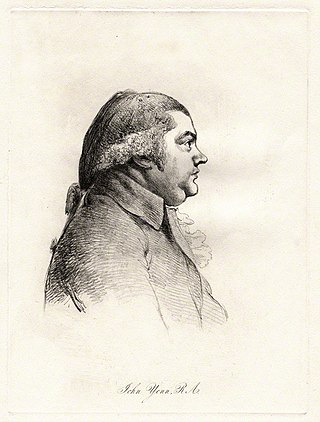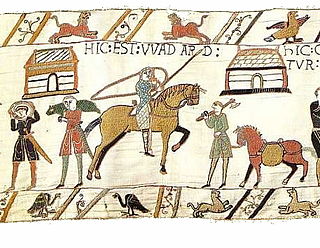Related Research Articles

Woodstock Palace was a royal residence in the English town of Woodstock, Oxfordshire.

Woodstock is a market town and civil parish, 8 miles (13 km) north-west of Oxford in West Oxfordshire in the county of Oxfordshire, England. The 2021 Census recorded a parish population of 3,521 up from the previous 3,100 in 2011.

Eynsham is a village and civil parish in the West Oxfordshire district, in Oxfordshire, England, about 5 miles (8 km) north-west of Oxford and east of Witney. The 2011 Census recorded a parish population of 4,648. It was estimated at 5,087 in 2020.

John Yenn (1750–1821) was a notable 18th-century English architect.

Begbroke is a village and civil parish in Oxfordshire about one mile (1.6 km) west of Kidlington and five miles (8 km) northwest of Oxford. The 2011 Census recorded the parish's population as 783.

Long Hanborough is a village in Hanborough civil parish, about 4 miles (6.4 km) northeast of Witney in West Oxfordshire, England. The village is the major settlement in Hanborough parish. The 2011 Census recorded the parish's population as 2,630.

Bladon is a village and civil parish on the River Glyme about 6+1⁄2 miles (10.5 km) northwest of Oxford, Oxfordshire, England. It is where Sir Winston Churchill is buried. The 2011 Census recorded the parish's population as 898.

St Martin's Church in Bladon near Woodstock, Oxfordshire, England, is the Church of England parish church of Bladon-with-Woodstock. It is also the mother church of St Mary Magdalene at Woodstock, which was originally a chapel of ease. It is best known for the graves of the Spencer-Churchill family, including Sir Winston Churchill, in its churchyard.

Cokethorpe School is a private day school in Witney, West Oxfordshire. The school was found in 1957 by Francis Brown. It is a member of HMC, IAPS, and The Society of Heads. The school has approximately 660 students from age 4 to 18.

Summertown in North Oxford is a suburb of Oxford, England. Summertown is a one-mile square residential area, north of St Giles, the boulevard leading out of Oxford's city centre. Summertown is home to several independent schools and the city's most expensive houses. On both sides of Banbury Road are Summertown's popular shops. There is also a smaller street of shops and restaurants, South Parade, that links Banbury Road and Woodstock Road. Summertown is home to much of Oxford's broadcast media. BBC Radio Oxford and the BBC Television's Oxford studios are on Banbury Road. Start-ups also have an increasing presence on the parade, such as Brainomix and Passle. The studios for JACK FM, Glide FM, and Six TV Oxford are on Woodstock Road.

Yarnton is a village and civil parish in Oxfordshire about 1 mile (1.6 km) southwest of Kidlington and 4 miles (6 km) northwest of Oxford. The 2011 Census recorded the parish's population as 2,545.

Cassington is a village and civil parish in Oxfordshire about 5 miles (8 km) northwest of Oxford. The village lies on gravel strata about 1⁄2 mile (800 m) from the confluence of the River Evenlode with the River Thames. The parish includes the hamlet of Worton northeast of the village and the site of the former hamlet of Somerford to the south. Somerford seems to have been abandoned early in the 14th century. Cassington is formed of two parts, "upper" and "lower", each with its own village green. The 2011 Census recorded the parish's population as 750.

Shipton-on-Cherwell is a village in the civil parish of Shipton-on-Cherwell and Thrupp, in the Cherwell district, in the county of Oxfordshire, England. It is on the River Cherwell about 2 miles (3 km) north of Kidlington in Oxfordshire, England.
Sir John Walter was an English judge and Member of Parliament.
Worton is a hamlet in Cassington civil parish, 4.5 miles (7.2 km) northwest of Oxford.

Shipton-on-Cherwell and Thrupp is a civil parish in the Cherwell district, in the county of Oxfordshire, England. It was formed in 1955 by removing the hamlet of Thrupp from the parish of Kidlington and merging it with the parish of Shipton-on-Cherwell. It covers 6.04 km² and as at the 2011 census had 493 residents.
Hanborough is a civil parish in West Oxfordshire. The parish includes the villages of Church Hanborough and Long Hanborough. The village of Freeland was transferred from Eynsham civil parish to Hanborough in 1932 and then detached to form a separate civil parish in 1948. Both Church Hanborough and Long Hanborough are served by Hanborough railway station.

The Honour of Wallingford was a medieval English feudal barony which existed between 1066 and 1540 with its caput at Wallingford Castle in present-day Oxfordshire.

The Bear Hotel is a hotel in Woodstock, Oxfordshire, located opposite The Oxfordshire Museum, not far from Blenheim Palace. It is one of England's original 13th-century coaching inns and has stone walls, oak beams, open fireplaces and an ivy facade. The hotel has 53 bedrooms and its restaurant has 2 A.A. Rosettes and 2 RAC Dining Awards. It is run by MacDonald Hotels and Resorts. Notable guests include Richard Burton and Elizabeth Taylor who stayed at the hotel on many occasions in the Marlboro suite.

Wadard was an 11th-century Norman nobleman who is mentioned in the Domesday Book of 1086, and is depicted in the Bayeux Tapestry.
References
- ↑ Carr, William, University College , Routledge, 1998. ISBN 978-0-415-18632-2. Chapter V, The Sixteenth Century (pages 74–94).
- ↑ Darwall-Smith, Robin, A History of University College, Oxford. Oxford University Press, 2008. ISBN 978-0-19-928429-0. Leonard Hutchinson and the arrival of undergraduates, Pages 93–99.
- ↑ Alan Crossley, C. R. Elrington (Editors), A History of the County of Oxford: Volume 12: Wootton Hundred (South) including Woodstock (1990), Bladon: Church, pp. 31–34.
- ↑ Alan Crossley, C. R. Elrington (Editors), A History of the County of Oxford: Volume 12: Wootton Hundred (South) including Woodstock (1990), Yarnton: Church, pp. 484–487.